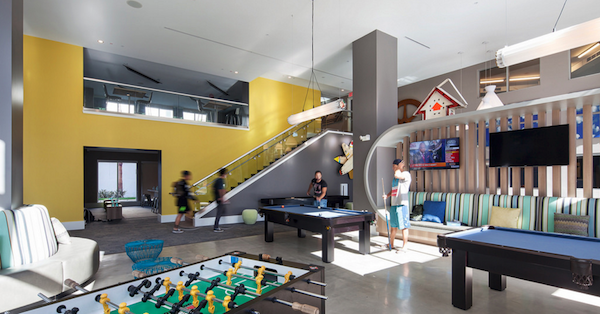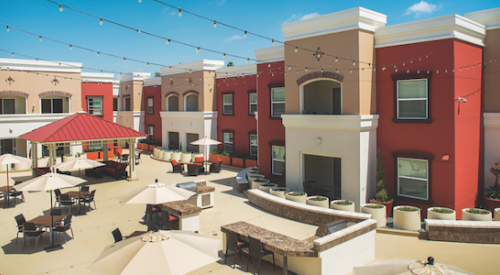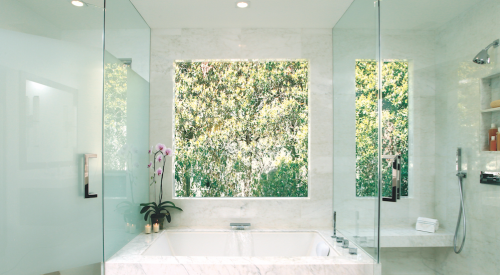Photo: Chang Kyun Kim Photography
As a newbie editor at Professional Builder in the late 1980s, I learned that home-design trends start in California and make their way east. I still believe that’s true. There’s plenty of good residential design in the so-called “flyover states,” but all home builders are wise to take note of what’s happening in the West (as well as in their own backyards, so to speak) as they create new product.
Here’s a summary of Midwest residential real-estate trends for 2016 that recently came across my desk. Many thanks to Kim Manning and Sarah Lyons at marketing and media-relations firm Taylor Johnson, in Niles, Ill., for putting it together.
1. Developers think body and soul. Features dedicated to the well-being of both the body and soul are becoming a must-have for renters and buyers alike. David Kennedy, principal at KTGY Architecture & Planning’s Chicago/Midwest office, sees “an evolution to more emphasis on overall wellness rather than strictly entertainment and recreation.” And Elissa Morgante, co-principal of Morgante Wilson Architects, in Evanston, Ill., notes that more single-family homebuyers are requesting yoga rooms and meditation areas.
2. Down-to-earth living takes root. As farm-to-table increases in popularity, people will be looking to bring that trend closer to home in 2016. Prairie Crossing (in my home town of Grayslake) and Serosun Farms, in Hampshire, Ill., give residents access to the bounty of working organic farms. Even apartment communities are planting herb gardens for the enjoyment of residents.
3. Empty nesters flock close to home. A growing number of empty nesters are choosing to downsize within the same state rather than move to warmer locales. Developer Jerry S. James, president of Edward R. James Cos., in Glenview, Ill., expects to see even more boomers forego the traditional snowbird migration. They usually opt for smaller detached homes, townhomes, or condominiums that require less maintenance but offer the bells and whistles of a new home.
4. Secondary spaces take center stage. Buyers will look for ways to showcase their personal style within a smaller footprint and likely turn to secondary spaces as an outlet. Jeff Benach, co-principal of Lexington Homes, in Chicago, says some buyers are “adding distinct design elements to one small but high-impact part of the home, such as a powder room that every visitor and guest will see.” Kitchen pantries, walk-in closets, and mudrooms are also areas of special focus.
5. Vacation homes have their day in the sun. Many experts are predicting that vacation-home sales will continue to sell briskly in 2016 (give the boomers credit for that one). But although retirees might be fueling the market, buyers across the board are purchasing vacation homes in order to spend meaningful time with their families. “In fact, there is increased demand for larger single-family homes in our community because buyers want a retreat where their entire extended family can gather,” says Tammy Barry, director of sales and marketing for Heritage Harbor Ottawa Resort, in Ottawa, Ill.
6. Get your game on. The year ahead will see a revamping of the traditional game room (for an example, see photo, above) as builders look for new ways to differentiate their product. KTGY’s Kennedy says this updated focus on gaming-style amenities is driven by Millennial renters. “We’re also seeing a trend toward vintage arcade-style games, including nostalgic offerings like tabletop shuffleboard,” he says.
7. Delivery dilemmas. With residents increasingly using the Internet to shop for everything from clothing and toiletries to groceries and household items, multifamily developers are paying more attention than ever to the logistics of delivering hundreds of packages each day. Chicago-based RMK Management uses a scan-and-notify electronic package-management system in addition to offering extra storage space at the nearly 30 communities it manages across the Midwest.
8. Master baths go minimalist. Many Midwest real-estate experts predict that sweeping master baths with supersized showers and tubs will fall out of favor with buyers this year. At Provenance in Northbrook, Ill., Red Seal Homes is shifting square footage from the master bath to a master sitting room, dressing room, or larger walk-in closet. “Buyers are preferring a walk-in shower with a custom tile base over the separate shower and soaking tub, which takes up far more space,” says Red Seal’s Brian Hoffman. Chicago’s Sedgwick Properties has started eliminating tubs in favor of larger, standalone showers, since other bathrooms in the home typically have a tub for guests. But even though it might be smaller, buyers still want the master bath to have luxurious finishes and fixtures, says Sedgwick president Marty Paris.
Perhaps the biggest change is the overall perception of the master bath. “Many of these larger master baths were modeled after spas or hotels, but some homeowners discovered they would rather go to the spa for the full experience rather than try to replicate it in their home,” says Jeanine McShea, managing director of Related Realty, in Chicago.












